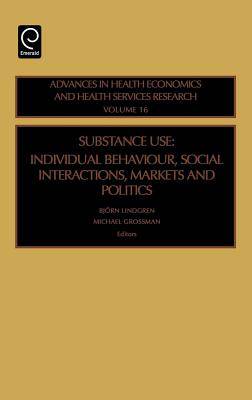
- Afhalen na 1 uur in een winkel met voorraad
- Gratis thuislevering in België vanaf € 30
- Ruim aanbod met 7 miljoen producten
- Afhalen na 1 uur in een winkel met voorraad
- Gratis thuislevering in België vanaf € 30
- Ruim aanbod met 7 miljoen producten
Zoeken
Substance Use
Individual Behavior, Social Interaction, Markets and Politics
€ 315,95
+ 631 punten
Omschrijving
The economics of substance use and abuse deals with the consumption of goods that share two properties. First, they are addictive in the sense that an increase in past consumption of the good leads to an increase in current consumption. Second, their consumption harms the consumer and others. This second property makes them of interest from policy, legal, and public health perspectives. The tremendous expansion in research in the economics of substance use and abuse since the early 1980s and the presence of many unresolved issues motivate this volume. While most of the papers are by economists, the disciplines of medicine, political science, and psychology are also represented. Any successful attempt to address substance use must adopt an interdisciplinary perspective. The aim of the volume to cover issues pertaining to individual behavior, social interactions, markets, and politics makes this all the more necessary. Some of the twenty papers in the volume contain new estimates of the price sensitivity of alcohol, cigarettes, marijuana, cocaine, and heroin. Others focus on the effects of consumption on earnings, crime, suicide, and sexually transmitted diseases. Still others address the roles of psychobiology, social interaction, hyperbolic discounting, and peer effects in shaping decisions with regard to the use of harmfully addictive substances. To a larger or lesser extent, all the papers contain implications for policy-making. A number of papers, however, are more directly concerned with policy-making and with the policy-making environment, including evaluations of the costs and benefits of treatment services for abusers. Readers of this volume should gain a much better understanding of what we know and what we still need to know about the economics of substance use and abuse.
Specificaties
Betrokkenen
- Uitgeverij:
Inhoud
- Aantal bladzijden:
- 478
- Taal:
- Engels
- Reeks:
- Reeksnummer:
- nr. 16
Eigenschappen
- Productcode (EAN):
- 9780762312337
- Verschijningsdatum:
- 5/08/2005
- Uitvoering:
- Hardcover
- Formaat:
- Genaaid
- Afmetingen:
- 161 mm x 235 mm
- Gewicht:
- 925 g

Alleen bij Standaard Boekhandel
+ 631 punten op je klantenkaart van Standaard Boekhandel
Beoordelingen
We publiceren alleen reviews die voldoen aan de voorwaarden voor reviews. Bekijk onze voorwaarden voor reviews.







